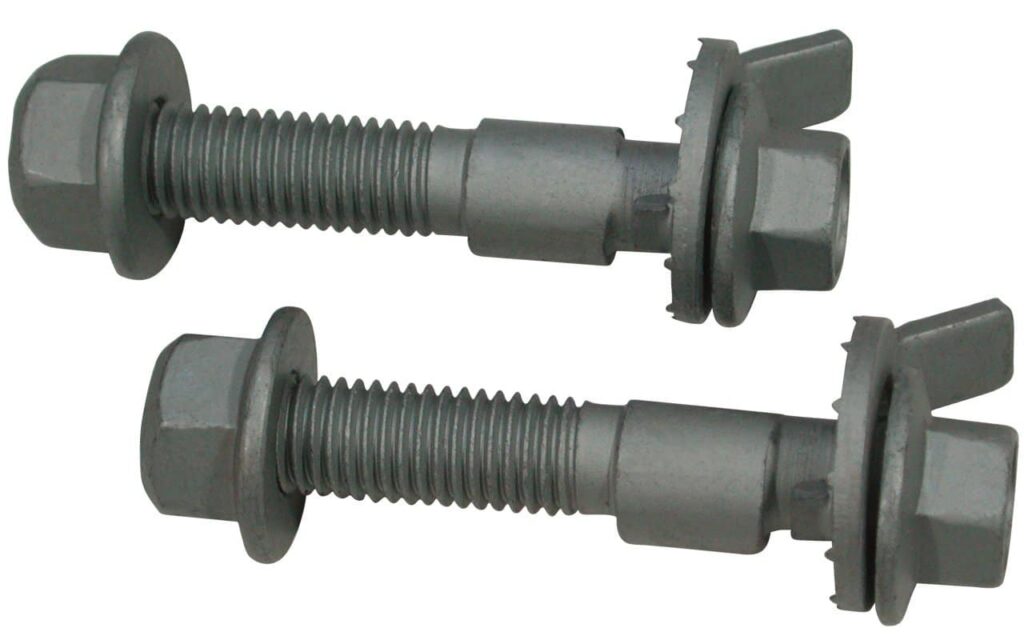While camber gets all the attention, a more effective way to tighten up the handling of your car is to adjust it’s caster angle. But what is caster angle, and how does it affect your ride?
In this guide, we break down everything there is to know about caster angle, negative and positive caster, and the various handling effects they have on your car.
What Is Caster Angle?
While camber is the side-to-side tilt of your tire, caster, also known as “mechanical trail” is the front to rear positioning. It doesn’t make much sense without a little context — how can a tire tilt from front to rear since it’s a circle?
But everything gets a little clearer when you realize we’re talking about the upper and lower mounting of the hub assembly in relation to your tire.
Caster angle refers to the location of your vehicle’s upper ball joint or strut mount compared to the lower ball joint.

Positive Caster
If your upper ball joint or strut mount is located more toward your vehicle’s rear than the lower ball joint, your vehicle has a positive caster.
There are several advantages to a vehicle with a positive caster — these include increased steering angles and better straight-line tracking.
It basically means you won’t have to turn the wheel as often to correct for divots and bumps in the road.
Positive caster improves your vehicle’s responsiveness when rounding corners and improves your vehicle’s stability when traveling at higher speeds.
The only downside to positive caster is that it increases the effort it takes to steer your vehicle. But since almost every modern vehicle comes equipped with power steering, you’ll barely notice the difference.
The bottom line is that when it comes to positive caster, there’s nothing to not love.
Performance Benefits of Positive Caster
A positive caster angle has a slew of performance advantages that can take your vehicle to the next level. As long as your vehicle has power steering, and unless you drive a Model T or other antique vehicle, there are no disadvantages to positive caster.
You get better handling when cornering, better stability at high speeds, and better straight-line tracking. The better traction while cornering is similar to a vehicle with negative camber, as it keeps more tread on the ground despite the sharp angles. A larger contact patch means more grip, and that’s never a bad thing.
Whether you’re heading to the track or the highway, these are advantages you want on your vehicle.

Negative Caster
As you may have guessed, negative caster is the exact opposite of positive caster. When the upper ball joint or strut mount is more towards the vehicle’s front than the lower ball joint, the vehicle has a negative caster.
While a positive caster has several advantages, there are no advantages to a negative caster in modern vehicles. In fact, it can lead to significant performance concerns.
Vehicles with negative caster suffer from reduced stability and poor handling. Because of this, you’ll typically find negative caster in older vehicles with outdated steering systems.
Historic and class cars had negative caster, which made their non-powered steering systems much lighter. Ever been in an old car that has very heavy steering? Negative caster would help with this. For modern vehicles, however, power steering has made that advantage obsolete.
Effects of Negative Caster
You should never intentionally adjust your car’s suspension in a way that gives it a negative caster angle. The result will be a vehicle with less traction and poor handling.
The only advantage to negative caster is that it’s easier to turn the steering wheel. But unless you have a vehicle without power steering, you won’t even notice the difference.

Even if your power steering fails, modern vehicles are incredibly difficult to drive without power steering, regardless of the caster angle.
Zero Caster Angle
Smack right in the middle of positive and negative caster is the compromise — zero caster. Zero caster happens when your upper ball joint or strut mount is directly in line with the lower ball joint.
While zero caster is better than negative caster in modern vehicles, it’s far from perfect. It’s also incredibly rare. That’s because vehicles with power steering tend to have a positive caster, and vehicles without power steering typically have a negative caster.
There’s simply no need for a vehicle with a zero caster.
Performance Benefits of Zero Caster
A zero caster isn’t bad, but it doesn’t do anything to improve performance either. You get slightly worse handling than positive caster and somewhat better handling than negative caster.
Steering is slightly easier than positive caster and marginally harder than a negative caster. It’s genuinely the in-between for negative and positive caster in just about every way. Because of this, there isn’t much need for vehicles with zero caster.
If the vehicle has power steering, they opt for positive caster, and if they don’t, they use negative caster — it’s just that simple.
How to Adjust Your Caster Angle
Firstly, it’s important to note that you can’t always adjust your car’s caster, especially in front-wheel drive vehicles. If your car doesn’t provide a way for you to adjust the caster independently, your only hope is to adjust the camber and hope that it shifts the caster to spec.
If it doesn’t, your vehicle has either damage or wear to the suspension components. However, some vehicles do have ways for you to adjust the caster angle.
Camber and caster adjustment bolts are a possible option. These are eccentric bolts that can change your angle by a few degrees.

The most common way to adjust your caster angle involves adding or removing shims to obtain the proper angle. You can add or remove shims from the rear bolt or where the upper control arm attaches to the hub.
Keep in mind that while this method will allow you to change the caster angle by a few degrees, you won’t be able to turn a negative caster into a positive caster or vice versa.
Remember, adjusting your caster angle will adjust the camber too, so make sure to readjust the camber angle afterward.
Making any changes beyond a few degrees would require a significant overhaul of your suspension system, and this isn’t a common way to alter your vehicle, so you’ll likely end up needing some aftermarket car parts.

Other Ways to Improve Performance and Handling
While adjusting your caster angle by a few degrees is one of the most effective ways to get more out of your vehicle, there are other tips and tricks you can use to set your vehicle over the top.
Another way to improve performance is with the help of a staggered wheelset. Wider wheels in the rear of your vehicle will give you more traction when both braking and accelerating.
Furthermore, performance upgrades, like aftermarket superchargers, intakes, and exhaust systems, are great ways to improve your vehicle. Just know that any significant upgrades to your engine will demand that you tune your car to prevent engine damage.
A final change you can make to improve your vehicle’s handling is to keep an eye on your vehicle’s tires. Check our guide to the best tire pressure gauges for racing. It sounds simple, and it is, but drivers often overlook it.
Weather changes drastically alter your tire pressure, and unless you’re keeping an eye on it, you’re losing traction every time you step in your vehicle.
A Quick Summary of Caster Angle: Keep it Positive!
If you’re looking for a cheap way to get a little more out of your car, adjusting your caster angle might be just what you need.
Or maybe you’re trying to figure out why your vehicle isn’t handling right after that last tire change and don’t want to spend a ton of money trying to improve it.
It’s simple, positive caster is a positive thing while negative caster is a negative thing. So keep it positive!
If you liked what you read here leave a comment below or check out some of our other guides for even more automotive knowledge.


3 comments
I love your suspension angle articles, I have such a clearer understanding of the concept now. Thank you!
Learned the above mentioned stuff in my Bachelor of Engineering studies but wanted to have a look again, just to recall. Really nice explanation and insightful article.
Your explaination is quiet impacting, I have grasped an amazing understanding on camber and caster angles in cars. Compliments to you.